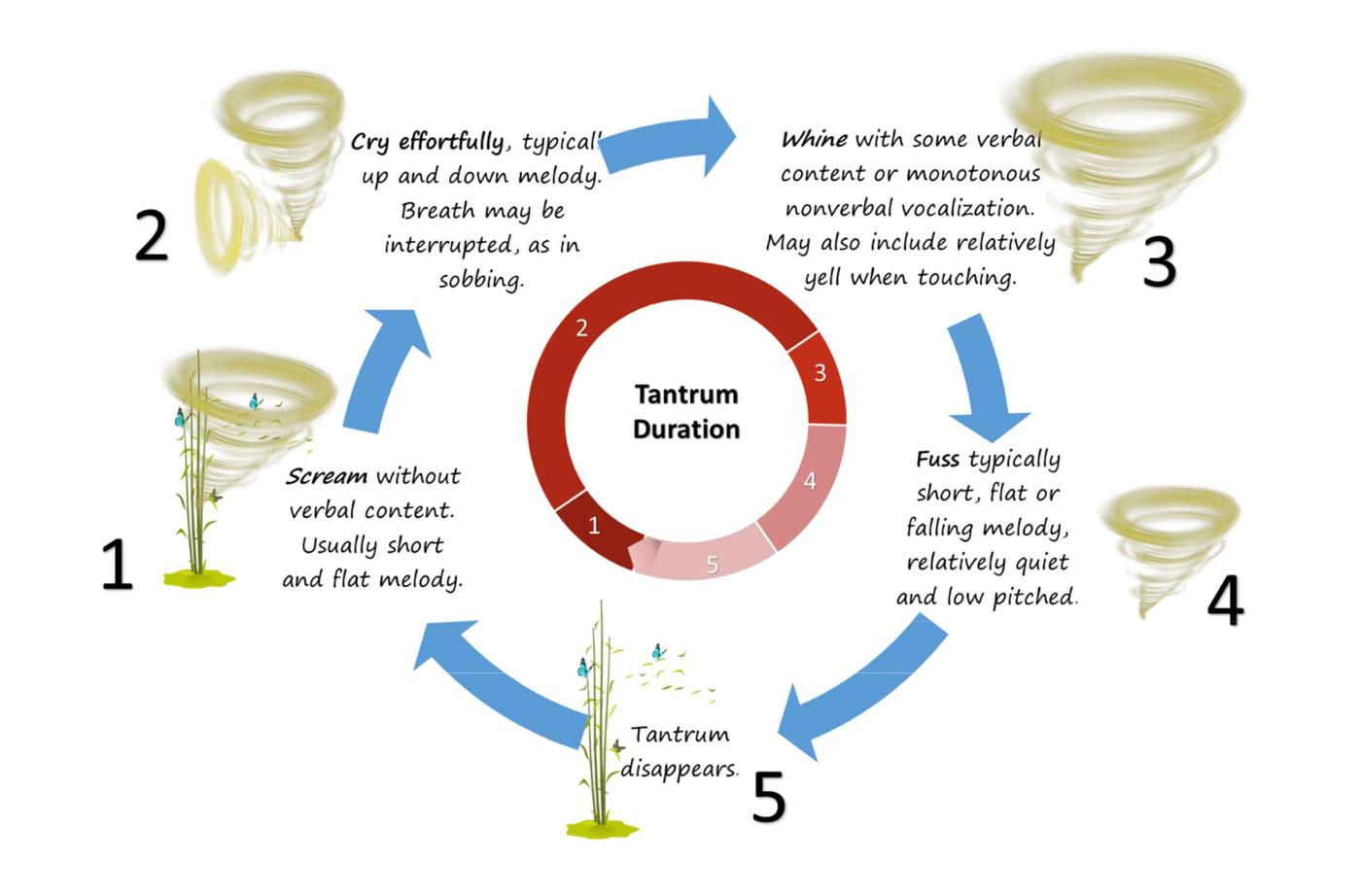Temper tantrum is a normal behaviour of your child’s development due to lack of language to communicate their wants and needs.
When children have tantrums
The first tantrum may happen around the age of 12-15 months as toddlers become more mobile and more aware of their likes or dislikes. Tantrums typically peak between the ages of 18- 56 months.
Tantrum’s course:
As shown in Figure, there are five levels in the tantrum’s course which a child will go through.

How to prevent tantrum from happening:
1. Teach your child how to ask for assistance
2. Provide schedules and routines for children to follow
3. Teach your child how to handle frustration.
4. Being role model, you should avoid:
Lecture, scold or argue
conflicts with your partner in front of your child
Compare him or her with another child
Tantrum’s characteristic:
Children like attention from their parents. Attention can be both positive and negative. Negative attention includes things like scolding, correcting, and yelling. Therefore, tantrums become more complex with your attention during the course.
How to handle tantrums well:
- Ignore displays of anger such crying, screaming or kicking during level 1,2, 3 of tantrums‘ course. It’s okay! You can cut down the power of tantrum as soon as you just stand nearby without talking, leave toys and take control.
- If a child is in the throes of a tantrum (at the level 1,2 and 3), the best strategy to use, if possible, is to completely ignore his behaviour until tantrum is ran out of energy at the level 4.
- Do not give the child what he or she wants (for example a preferred toys to coax the child into good behaviour). Giving the child what he or she wants will likely end the tantrum but will also teach the child having a tantrum is an effective means of getting his or her way.
- After the first 3 levels ends, the parent and child can come back together to talk about what’s happened without all of the emotion that surrounded the misbehaviour.
Using “a special tool” to intervene into tantrum
A. Distraction
B. 1-2-3 Go & Magic
C. Time-out
Questions and Answers:
Q: What if my child tries to get up before time-out is over?
A: You return him to Time-out zone and tell him that he is going to lose a privilege. For example, you might say in a calm voice, “If you stand up again, you will not be able to play with this doll the rest of the day.” Remember to follow through with all consequences you promise. Also, remember that consequences that occur right away work best for young children.
Q: What if your child is in time-out and says that he has to go to the bathroom?
A: According to the CDC’s advice, you should ignore all of the things your child says while in time-out. If your child uses the bathroom in the time-out spot, it can be cleaned up easily. Your child may use the bathroom on himself every time he’s in time-out if he knows it will get him out of time-out sooner. If your child is necessary to go to bathroom, you can take him to the bathroom but limit what you say or do. Your eye, verbal, and physical contact should be limited to only what is needed to help him with the bathroom. After using the bathroom, take him right back to the time-out chair.
Q: What if my child is scream and cry during time-out?
A: Professor Waston T.S., University of Washington, US stated “When you first start using time-out, your child may scream or cry. This behavior is not abnormal and you can just ignore it. She’ll likely stop this after several time-outs.” If your child is not quiet during the last 5 seconds of time-out, wait until she has been quiet for at least 5 seconds before allowing her to get out of time-out. You don’t want her to think she’s getting out of time-out because she has been crying or screaming.
Q: What if your child picks up a toy and takes it with him while he’s on the way to timeout?
A: Take it away. Remember that time-out is a time away from all things that may be fun or entertaining for your child, Dr. Mark from CDC, stated . No toys are allowed in time-out. Moreover, choose Time-out spot that is away from attention, entertainment, and distractions, such as TV, Ipad, Sofa and bedroom.
Q: What if your child misbehaves away from home?
A: Tantrums can be thrown anywhere (the grocery store, the bookstore and the church). You may take her to a place that is not surrounded by people. For example, taking your child to bathroom stall or outside the store. Let him or her go through the tantrums or using 1-2-3 Go & Magic to take control first. Then, if she or he still misbehaving, it still needs to be a timeout. Your child might face a wall or something boring, as a right spot for Time-out.
References:
- Green, J. A., Whitney, P. G., & Potegal, M. (2011). Screaming, Yelling, Whining and Crying: Categorical and intensity differences in Vocal Expressions of Anger and Sadness in Children’s Tantrums. Emotion (Washington, D.C.), 11(5), 1124–1133.
- Daniel J.S. và Tina P.B. (2011) The whole-brain child- 12 Revolutionary strategies to nurture your child developing mind. Delacorte Press. New York.
- Waston T.S., Gebhardt S. & Watson T. (2010) temper tantrums: Guidelines for parents and teachers. National Association of School Psychologists. Helping children at home and school.
- CDC (2017) Handling Time-Out Challenges. Accessed 15 April 2018


